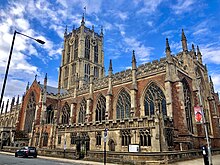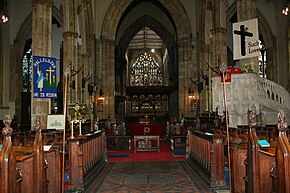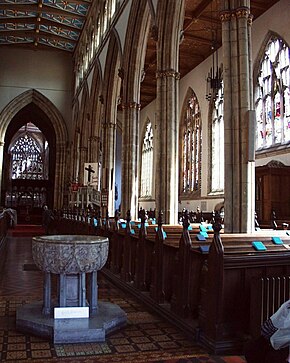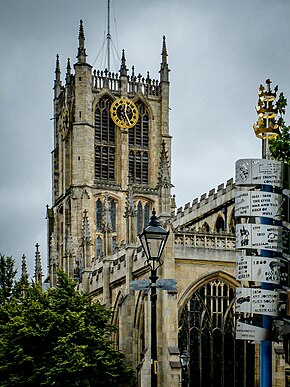Hull Minster
| Hull Minster | |
|---|---|
| Holy Trinity Church | |
 Hull Minster | |
 | |
| OS grid reference | TA 09963 28554 |
| Country | England |
| Denomination | Church of England |
| Previous denomination | Catholic Church |
| Churchmanship | Low Church |
| Website | HullMinster.org |
| History | |
| Status | Minster |
| Dedication | Holy Trinity |
| Architecture | |
| Style | Perpendicular Gothic |
| Years built | c. 1285[1] transepts 1300–20 choir 1340–70 nave 1380–1420 tower 1490–1520 |
| Specifications | |
| Length | 285 feet (87 m) |
| Nave width | 72 feet (22 m) |
| Tower height | 150 feet (46 m) |
| Administration | |
| Province | Province of York |
| Diocese | Diocese of York |
| Archdeaconry | East Riding |
| Deanery | Kingston upon Hull |
| Benefice | Kingston upon Hull Holy Trinity |
| Parish | The Most Holy and Undivided Trinity Kingston upon Hull |
| Clergy | |
| Vicar(s) | Revd Dominic Black |
| Curate(s) | Revd Irene Wilson |
| Laity | |
| Organist/Director of music | Mr Mark Keith |
| Churchwarden(s) | Kate Goforth, Robert Carlisle |


Hull Minster is the Anglican minster and the parish church of Kingston upon Hull in the East Riding of Yorkshire, England. The church was called Holy Trinity Church until 13 May 2017 when it became Hull Minster.
History
[edit]| Trinity Church Hull Act 1661 | |
|---|---|
| Act of Parliament | |
 | |
| Long title | An Act for dividing Trynity Church, in Kingston upon Hull, from Hassle. |
| Citation | 13 Cha. 2. St. 2. c. 2 |
| Dates | |
| Royal assent | 20 December 1661 |
The transepts date from c. 1300–20, the choir is estimated at 1340–70, the nave 1380–1420 and the tower 1490–1520.[2] In the early to mid 18th century, the brickwork of the choir and transepts was covered with stucco, later removed in a restoration of the church by Henry Francis Lockwood between 1842-45.[2] During this restoration the galleries and pews were removed. The stonework was cleaned of paint. The nave was fitted with oak stalls enriched with poppy heads, carved by George Peck of Hull. Many of the poppy heads were executed from casts of existing models in Lincoln Cathedral. Central heating consisting of iron pipework was installed in the nave by Mr. Reid of Hull. The ceiling was decorated mainly in ultra-marine blue, with beams picked out in Crimson and gold.[3]
In 1861 a lengthy restoration of the church was begun under the direction of the architect Sir George Gilbert Scott which lasted until 1878 and cost £32,750[4] (equivalent to £4,015,000 in 2023).[5]
In 1906 it was discovered that the tower was in danger, resulting in emergency work to underpin the church with concrete and rebuild the nave piers. This was done under the direction of the architect Frederick Stead Brodrick.[6]
It is the largest parish church in England by floor area,[7] and contains what is widely acknowledged to be some of the finest medieval brick-work in the country, particularly in the transepts. The Minster Church is a Grade I listed building.[8]
The Minster Church is a member of the Greater Churches Group.
William Wilberforce, who led the parliamentary campaign against the slave trade, was baptised in Holy Trinity Church in 1759.[9]
The Church was lucky to escape serious damage from the very heavy bombing that Hull endured in both world wars. Hull was an easy target for the Luftwaffe to find on account of its proximity to the Humber Estuary and the North Sea.
In November 2014 plans were unveiled to reorder the church, creating an outstanding venue for performances, exhibitions and banquets, a visitor destination, and a place where those in need of help can find assistance. The aim was to create a place for the whole community, and a venue that would be a driving force in the regeneration of Hull's Old Town. The transformation, costing a total of £4.5 million, was to take place in phases from 2016 onwards, the first being ready for Hull's role as UK City of Culture in 2017.[10]
On 7 November 2016 the then Archbishop of York, John Sentamu, announced that the church would be given Minster status in a ceremony on 13 May 2017.[11] Sentamu came to Hull on 13 May in a flotilla of boats with a lantern lit at All Saints' Church, Hessle, to rededicate the church as Hull Minster.[12]
In March 2019 the Minster received a grant of £3.9 million from Highways England to create a visitor centre, café and exhibition spaces.[13]
Tower
[edit]Clock
[edit]
The clock in the tower was originally built by Joseph Hindley of York in 1772 with one face.[14]
The single dial of the clock was replaced in 1840 by James Harrison IV who installed a new clock mechanism and four 13.25 feet (4.04 m) dials, which were at this point the largest parish church clock dials in England.[15] The minute hand was 9.33 feet (2.84 m) long, and the hour hand 8.33 feet (2.54 m).[16]
This clock mechanism was replaced in July 1913[17] by Potts of Leeds. It contains a Cambridge quarter-chiming clock. The dials by James Harrison of 1840 were retained.
Chimes
[edit]The first chime was installed in 1777. The chime mechanism was constructed by Mr. E. Todd of Mytongate, Hull. The barrel tunes were pinned by Joseph Hindley of York who had installed the clock in 1772. It had several tunes and had to be wound twice each day. It was restored in 1828[18] and 1865 and chimed on eight bells until 1898 when the bells were removed and recast by John Taylor and Co. of Loughborough.
A new set of chimes was installed in 1913 along with a new clock.[19]
In May 2013 a chime of 15 bells was installed which was supplemented in 2014 by 8 additional bells and 2017 by 2 further bells to bring the carillon to 25 bells.[20] The chimes are operated by a digital control box[21] but the chimes can be played manually from a keyboard.
Bells
[edit]In addition to the chimes, the tower contains a peal of 12 bells for full circle change ringing. Ten of the bells date from 1899 and 2 from 1959. All were cast by John Taylor of Loughborough.[20]
List of vicars
[edit]- 1326 Robert de Marton
- 1345 Peter de Aslaksby
- Peter de Walton
- 1349 Thomas de Baynbriggs
- 1349 Robert de Thornton
- 1362 John de Hurtheworth
- 1364 Richard Lestebury
- John Stayngreve
- 1391 Richard Marke
- 1400 John de Barton
- 1416 Thomas de Esyngwald
- 1420 Thomas Bywell
- 1433 Thomas de Bewyk
- 1444 Thomas Delyngton
- 1455 John Harewode
- 1467 William Meryngton
- 1468 John Yolton
- 1492 Robert Hedlam
- 1503 James Cokerell
- 1519 George Dent
- 1522 Thomas Logan
- 1538 William Peres
- 1557 Thomas Fugall
- 1561 Melchior Smyth
- 1591 Theophilus Smyth
- 1615 Richard Perrott
- 1642 William Styles
- 1689 Robert Banks
- 1715 John Wilkinson
- 1715 Charles Mace
- 1721 William Mason
- 1753 Arthur Robinson
- 1783 Thomas Clarke
- 1797 Joseph Milner
- 1797 John Healey Bromby
- 1867 Richard England Brooke
- 1875 Joseph M'Cormick
- 1894 John William Mills
- 1895 Joshua Hughes-Games
- 1904 Arthur Blackwell Goulburn Lillingston
- 1914 Louis George Buchanan
- 1924 Cecil Francis Ayerst
- 1927 William Seldon Morgan
- 1937 Frederick Boreham
- 1947 Leslie Oldfield Kenyon
- 1956 Reginald Iliff
- 1967 Gerald Bernard Bridgman
- 1988 John Watson Waller
- 2002 James Oliphant Forrester
- 2010 Neal Duncan Barnes
- 2020 Dominic Paul Black
Organ
[edit]Letters in the possession of the Corporation of Hull from an Archbishop of York to the Mayor and aldermen of Kingston upon Hull dating from 1622–23 refer to the organs that in former times adorned your church and requests that these may be restored and used and that a builder, one John Roper, be employed for this work.[22]
The first post English Civil War organ is believed to have been the work of "Father" Smith in 1711–12,[23] an organ he built originally in 1704 for St Paul's Cathedral London, but which was subsequently removed from there as being too small. This organ was further enlarged by John Snetzler during the 18th century. Ryley of York produced a new organ in 1788. Forster & Andrews built and enlarged organs between 1845[24] and 1908, their last organ providing the basis for the present substantially enlarged organ of 4-manuals and 104 speaking stops by the John Compton Organ Company in 1938.[25]
A specification of the organ can be found on the National Pipe Organ Register.[26]
Organists
[edit]- Mr. Baker ???? – 1715
- George Smith 1715–1717
- Musgrave Heighington 1717–1720 (later organist of St Nicholas Church, Great Yarmouth)
- William Avison 1720–1751
- Matthias Hawdon 1751–1769 (later organist of Beverley Minster)
- John Hudson 1768–1787
- Thomas Hawdon 1787–1789
- George Lambert 1789–1838[27]
- George James Skelton 1838–1851[28] – 1868
- Thomas Craddock 1868–1875
- G. E. Jackman 1875–1881
- Fred K. Bentley 1881[29] – 1921[30] – 1929
- Norman Ewart Strafford 1929–1951[31]
- Peter Goodman 1951–1961[32] (previously organist of Guildford Cathedral)
- Ronald Arthur Styles 1961–1977
- Desmond Swinburn 1977–1986
- Julian Savory 1986–1991
- John Pemberton 1991
- Alan Dance, 1991–1999
- Roland Dee 1999–2004
- Paul Derrett and Serena Derrett 2005 – 2007
- Serena Derrett – Director of Music 2007 – 2015 (now known as Jerome Robertson)
- Mark Keith – Organist 2007 –
Organ Scholars
- David Thomas, 2011–2014
- Richard Harrison Cowley, 2017–2021
- Niamh Drew, 2021–2023
Gallery
[edit]- Hull Minster Front Outside
- Hull Minster Inside Font
- Hull Minster Inside
- Hull Minster Inside
- Hull Minster Inside
- Hull Minster Inside
- Hull Minster Inside
- Hull Minster Inside
- Hull Minster Inside
- Hull Minster Inside
- Hull Minster Inside
- Hull Minster Inside
- Hull Minster Inside
- Hull Minster Inside
- Hull Minster Inside
- Hull Minster Inside
- Hull Minster Inside
- Hull Minster Inside
- Hull Minster Inside
- Hull Minster Inside
- Hull Minster Inside
- Hull Minster Inside
- Hull Minster Inside
- Hull Minster Inside
- Hull Minster Inside
- Hull Minster Inside
- Hull Minster Inside
- Hull Minster Inside
- Hull Minster Inside
- Hull Minster Inside
See also
[edit]References
[edit]- ^ "Hull Minster". ferreyandmennim.co.uk. Archived from the original on 24 November 2018. Retrieved 20 May 2019.
- ^ a b Neave, David; Neave, Susan (2010). Pevsner Architectural Guides. Hull. Yale University Press. pp. 39–47. ISBN 9780300141726.
- ^ "Reopening of Holy Trinity Church". Hull Packet. England. 12 December 1845. Retrieved 20 July 2023 – via British Newspaper Archive.
- ^ "The Restoration of Holy Trinity Church". Hull Packet. England. 24 May 1878. Retrieved 20 July 2023 – via British Newspaper Archive.
- ^ UK Retail Price Index inflation figures are based on data from Clark, Gregory (2017). "The Annual RPI and Average Earnings for Britain, 1209 to Present (New Series)". MeasuringWorth. Retrieved 7 May 2024.
- ^ "Thanksgiving Service at Holy Trinity Church, Hull". Yorkshire Post and Leeds Intelligencer. England. 27 April 1908. Retrieved 20 July 2023 – via British Newspaper Archive.
- ^ "Holy Trinity Church, Hull". Holy Trinity Church. Archived from the original on 14 December 2007. Retrieved 12 June 2007.
- ^ Historic England. "Parish Church Of The Holy Trinity And Churchyard Wall (1292280)". National Heritage List for England. Retrieved 16 May 2017.
- ^ "History of the Church". Hull Minster. Archived from the original on 13 November 2017. Retrieved 6 August 2018.
- ^ "Hull's Holy Trinity Church plans for UK City of Culture 2017". BBC News. BBC. 7 November 2014. Retrieved 13 November 2014.
- ^ "Hull's Holy Trinity Church to become Minster on 13 May". BBC News. BBC. 7 November 2016. Retrieved 9 November 2016.
- ^ "Hull Minster: Holy Trinity Church re-dedicated". BBC News. BBC. 13 May 2017. Retrieved 16 May 2017.
- ^ "Hull Minster: Visitor centre plans given £3.9m cash boost". BBC News. BBC. 28 March 2019. Retrieved 28 March 2019.
- ^ Boyle, John Roberts (1890). Holy Trinity Church Hull. A Guide and Description. A. Brown; London, Simpkin, Marshall, Hamilton, Kent. p. 45.
- ^ McKay, Chris (2010). Big Ben: the Great Clock and the Bells at the Palace of Westminster. A. Brown; London, Simpkin, Marshall, Hamilton, Kent. p. 56. ISBN 9780191615085.
- ^ "Hull's Holy Trinity Church". Hull Daily Mail. England. 12 February 1925. Retrieved 22 July 2023 – via British Newspaper Archive.
- ^ "Restoration of Holy Trinity Chimes at Hull". Yorkshire Post and Leeds Intelligencer. England. 3 July 1913. Retrieved 22 July 2023 – via British Newspaper Archive.
- ^ "Curiosity". York Herald. England. 11 April 1829. Retrieved 22 July 2023 – via British Newspaper Archive.
- ^ "Stray Notes". Beverley and East Riding Recorder. England. 5 July 1913. Retrieved 22 July 2023 – via British Newspaper Archive.
- ^ a b "Kingston upon Hull, East Riding of Yorkshire, Minster Ch of the Most Holy & Undivided Trinity". Dove's Guide for Church Bell Ringers. Dovemaster. 17 April 2023. Retrieved 22 July 2023.
- ^ "Hull church gets a set of wirelessly controlled bells". BBC News. England. 27 December 2013. Retrieved 22 July 2023 – via BBC website.
- ^ "The Bicentenary of a Hull Organ". Leeds Post and Yorkshire Intellignecer. England. 17 April 1912. Retrieved 22 July 2023 – via British Newspaper Archive.
- ^ "Fine Organ". Hull Daily Mail. England. 26 July 1950. Retrieved 22 July 2023 – via British Newspaper Archive.
- ^ "Reopening of Holy Trinity Church". Hull Packet. England. 12 December 1845. Retrieved 20 July 2023 – via British Newspaper Archive.
- ^ "Organ rebuilt for £3,000". Hull Daily Mail. England. 2 March 1938. Retrieved 20 July 2023 – via British Newspaper Archive.
- ^ "Yorkshire, East Riding Kingston upon Hull, Hull Minster, (pre 2017 Holy Trinity), Market Place [N03966]". National Pipe Organ Register. British Institute of Organ Studies. Retrieved 3 October 2022.
- ^ Curious Epitaphs By William Andrews. READ BOOKS, 2008 ISBN 1-4086-8017-3
- ^ General Directory of Kingston-upon-Hull, and York, 1851, p.197
- ^ Dictionary of Organs and Organists. First Edition. 1912.
- ^ Dictionary of Organs and Organists. Second Edition. 1921. G. A. Mate (London)
- ^ Who's Who in Music. Shaw Publishing Co. Ltd. London. First Post-War Edition. 1949–50
- ^ The Succession of Organists of the Chapel Royal and Cathedrals of England and Wales. Watkins Shaw.


 French
French Deutsch
Deutsch




























